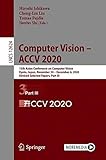Computer Vision – ACCV 2020 [electronic resource] : 15th Asian Conference on Computer Vision, Kyoto, Japan, November 30 – December 4, 2020, Revised Selected Papers, Part III /
Material type: TextSeries: Image Processing, Computer Vision, Pattern Recognition, and Graphics ; 12624Publisher: Cham : Springer International Publishing : Imprint: Springer, 2021Edition: 1st ed. 2021Description: XVIII, 757 p. 245 illus., 229 illus. in color. online resourceContent type:
TextSeries: Image Processing, Computer Vision, Pattern Recognition, and Graphics ; 12624Publisher: Cham : Springer International Publishing : Imprint: Springer, 2021Edition: 1st ed. 2021Description: XVIII, 757 p. 245 illus., 229 illus. in color. online resourceContent type: - text
- computer
- online resource
- 9783030695354
- 006.37 23
- TA1634
Recognition and Detection -- End-to-end Model-based Gait Recognition -- Horizontal Flipping Assisted Disentangled Feature Learning for Semi-Supervised Person Re-Identification -- MIX'EM: Unsupervised Image Classification using a Mixture of Embeddings -- Backbone Based Feature Enhancement for Object Detection -- Long-Term Cloth-Changing Person Re-identification -- Any-Shot Object Detection -- Background Learnable Cascade for Zero-Shot Object Detection -- Unsupervised Domain Adaptive Object Detection using Forward-Backward Cyclic Adaptation -- COG: COnsistent data auGmentation for object perception -- Synthesizing the Unseen for Zero-shot Object Detection -- Fully Supervised and Guided Distillation for One-Stage Detectors -- Visualizing Color-wise Saliency of Black-Box Image Classification Models -- ERIC: Extracting Relations Inferred from Convolutions -- D2D: Keypoint Extraction with Describe to Detect Approach -- Accurate Arbitrary-Shaped Scene Text Detection via Iterative Polynomial ParameterRegression -- Adaptive Spotting: Deep Reinforcement Object Search in 3D Point Clouds -- Efficient Large-Scale Semantic Visual Localization in 2D Maps -- Synthetic-to-Real Unsupervised Domain Adaptation for Scene Text Detection in the Wild -- Scale-Aware Polar Representation for Arbitrarily-Shaped Text Detection -- Branch Interaction Network for Person Re-identification -- BLT: Balancing Long-Tailed Datasets with Adversarially-Perturbed Images -- Jointly Discriminating and Frequent Visual Representation Mining -- Discrete Spatial Importance-Based Deep Weighted Hashing -- Low-level Sensor Fusion Network for 3D Vehicle Detection using Radar Range-Azimuth Heatmap and Monocular Image -- MLIFeat: Multi-level information fusion based deep local features -- CLASS: Cross-Level Attention and Supervision for Salient Objects Detection -- Cascaded Transposed Long-range Convolutions for Monocular Depth Estimation -- Optimization, Statistical Methods, and Learning -- Bridging Adversarial and Statistical Domain Transfer via Spectral Adaptation Networks -- Large-Scale Cross-Domain Few-Shot Learning -- Channel Pruning for Accelerating Convolutional Neural Networks via Wasserstein Metric -- Progressive Batching for Efficient Non-linear Least Squares -- Fast and Differentiable Message Passing on Pairwise Markov Random Fields -- A Calibration Method for the Generalized Imaging Model with Uncertain Calibration Target Coordinates -- Graph-based Heuristic Search for Module Selection Procedure in Neural Module Network -- Towards Fast and Robust Adversarial Training for Image Classification -- Few-Shot Zero-Shot Learning: Knowledge Transfer with Less Supervision -- Lossless Image Compression Using a Multi-Scale Progressive Statistical Model -- Spatial Class Distribution Shift in Unsupervised Domain Adaptation: Local Alignment Comes to Rescue -- Robot Vision -- Point Proposal based Instance Segmentation with Rectangular Masks for Robot Picking Task -- Multi-task Learning with Future States for Vision-based Autonomous Driving -- MTNAS: Search Multi-Task Networks for Autonomous Driving -- Compact and Fast Underwater Segmentation Network for Autonomous Underwater Vehicles -- L2R GAN: LiDAR-to-Radar Translation -- V2A - Vision to Action: Learning robotic arm actions based on vision and language -- To Filter Prune, or to Layer Prune, That Is The Question.
The six volume set of LNCS 12622-12627 constitutes the proceedings of the 15th Asian Conference on Computer Vision, ACCV 2020, held in Kyoto, Japan, in November/ December 2020.* The total of 254 contributions was carefully reviewed and selected from 768 submissions during two rounds of reviewing and improvement. The papers focus on the following topics: Part I: 3D computer vision; segmentation and grouping Part II: low-level vision, image processing; motion and tracking Part III: recognition and detection; optimization, statistical methods, and learning; robot vision Part IV: deep learning for computer vision, generative models for computer vision Part V: face, pose, action, and gesture; video analysis and event recognition; biomedical image analysis Part VI: applications of computer vision; vision for X; datasets and performance analysis *The conference was held virtually.


There are no comments on this title.